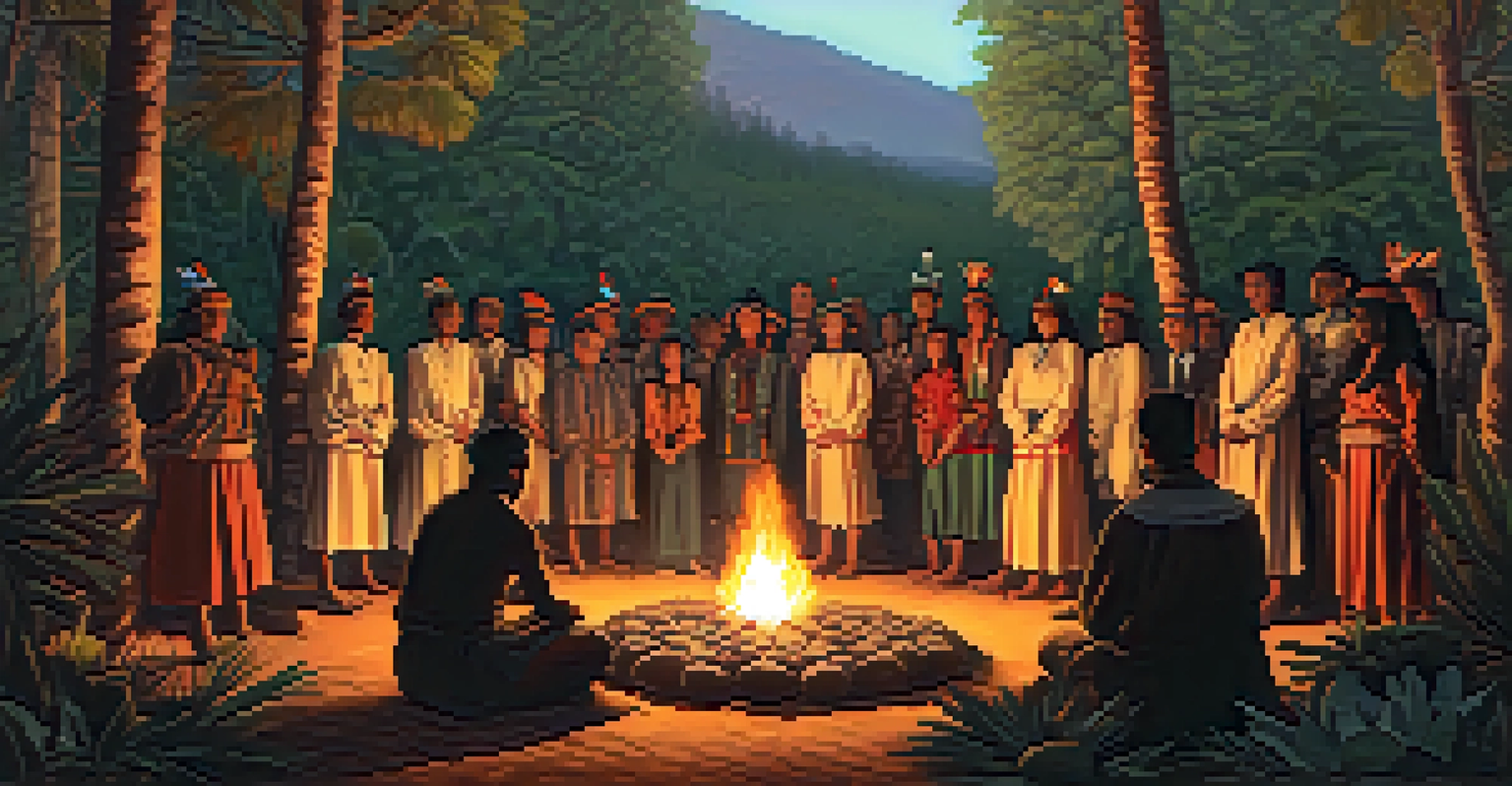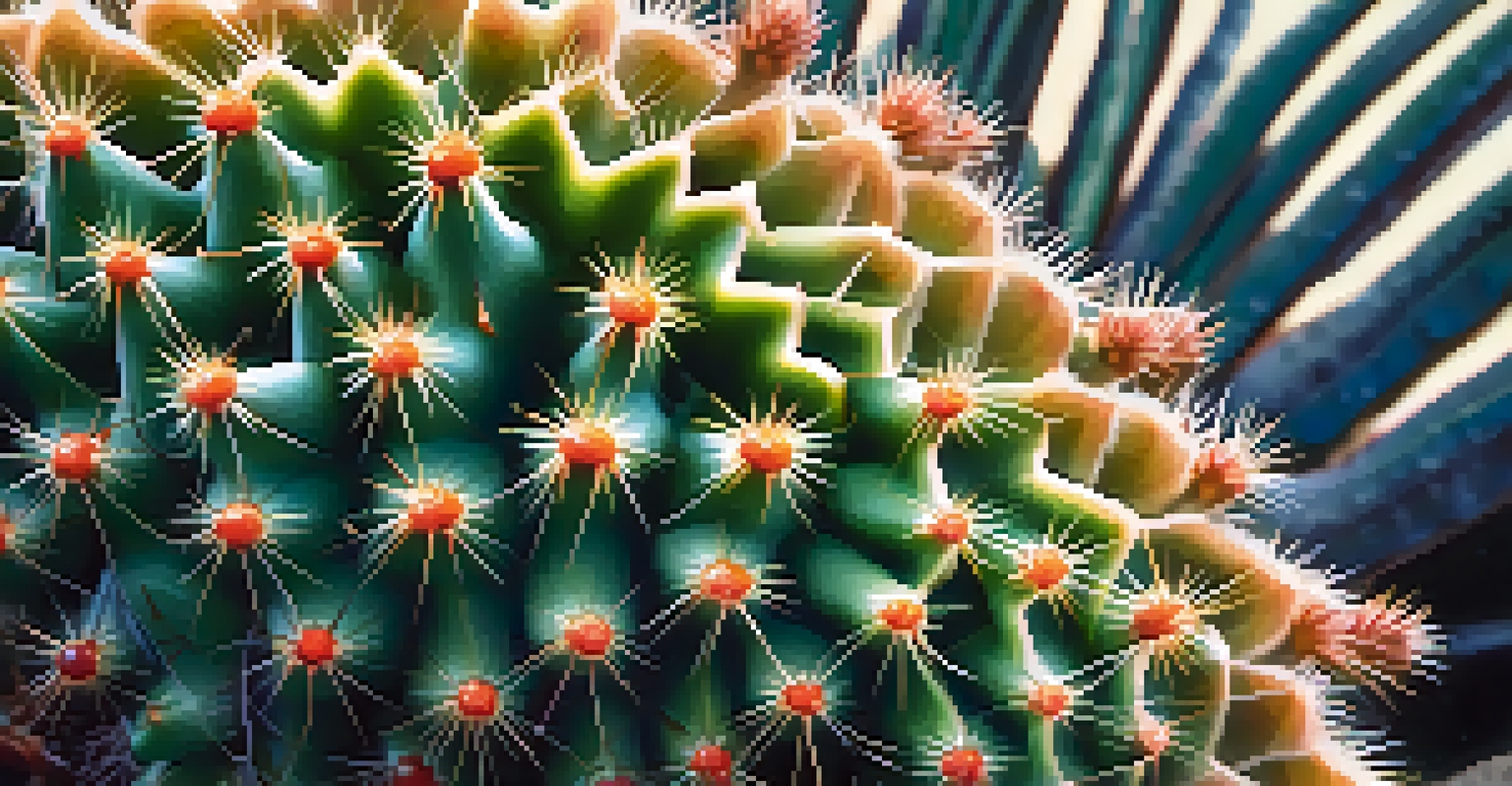Peyote's Role in Shaping Indigenous Community Identity Today

Understanding Peyote's Historical Significance
Peyote, a small cactus native to Mexico and the southwestern United States, has been a spiritual cornerstone for many Indigenous communities for centuries. Historically, it has been used in sacred rituals, providing a means for connection with the divine. This rich heritage has not only shaped spiritual practices but has also fostered a sense of unity among tribes.
The use of peyote is deeply intertwined with their identity, representing resilience and continuity of tradition.
For many Indigenous peoples, the use of peyote is deeply intertwined with their identity, representing resilience and continuity of tradition. The ceremonies surrounding its use often act as a space for communal gathering, reinforcing social bonds and cultural narratives. In this way, peyote serves as a cultural touchstone, reminding community members of their shared history and values.
As Indigenous communities navigate the complexities of modern life, the significance of peyote remains steadfast. It acts as a bridge between past and present, allowing individuals to connect with their ancestors while fostering community identity in contemporary society.
Peyote in Contemporary Indigenous Ceremonies
In today's world, peyote continues to play a vital role in ceremonial practices among Indigenous tribes, particularly within the Native American Church. These ceremonies provide a structured environment where participants can experience healing and spiritual growth. The ritualistic aspects of peyote use create a safe space for individuals to express their cultural heritage openly.

Moreover, peyote ceremonies often include teachings and stories passed down through generations, reinforcing important cultural values and beliefs. This transmission of knowledge helps younger generations understand their identity and the significance of their heritage. By participating in these rituals, community members can reclaim their narrative in a world that often marginalizes Indigenous voices.
Peyote's Role in Indigenous Identity
Peyote serves as a cultural touchstone for Indigenous communities, reinforcing their identity, traditions, and social bonds.
Through these contemporary practices, peyote not only serves as a plant but also as a symbol of resistance and cultural revival. The continued use of peyote highlights the importance of maintaining cultural identity amidst external pressures and challenges.
The Role of Peyote in Healing and Community Wellness
Peyote is often celebrated for its therapeutic properties, particularly in the context of mental health and emotional healing. Many Indigenous individuals turn to peyote as a means to navigate trauma, grief, and the challenges of modern life. The plant's psychoactive effects can lead to profound introspection and collective healing.
Peyote serves as a cultural touchstone, reminding community members of their shared history and values.
In ceremonies, participants often share their personal struggles and victories, fostering a sense of support and solidarity. This communal sharing not only aids in individual healing but also strengthens the overall well-being of the community. By addressing mental health issues within the context of cultural practices, Indigenous peoples reclaim agency over their healing journeys.
The healing potential of peyote extends beyond the individual, creating a ripple effect that enhances community resilience. As individuals heal, they contribute positively to their families and communities, reinforcing the interconnectedness that is a hallmark of Indigenous identity.
Challenges to Peyote's Cultural and Legal Status
Despite its significance, the use of peyote faces numerous challenges, particularly concerning legal protections and cultural appropriation. In the United States, peyote is classified as a Schedule I substance, which complicates its use outside of specific religious contexts. This legal status often leads to misunderstandings and stigmatization of Indigenous practices.
Moreover, the rise in interest around psychedelics has led to instances of cultural appropriation, where non-Indigenous individuals seek to use peyote outside its traditional context. This can dilute its cultural significance and undermine the spiritual practices of Indigenous peoples. Ensuring that peyote remains a sacred element of Indigenous identity requires vigilance and education about its proper context.
Healing Through Peyote Ceremonies
Peyote ceremonies facilitate mental health and emotional healing, fostering communal support and resilience among participants.
Advocacy for the protection of peyote and its cultural significance is crucial in combating these challenges. By raising awareness and fostering respectful dialogue, Indigenous communities can work toward preserving their traditions while educating others about the importance of peyote.
Peyote and Cultural Revitalization Efforts
The resurgence of interest in traditional practices has led to an increased emphasis on peyote as a means of cultural revitalization. Many Indigenous communities are actively reclaiming their ceremonial practices, often integrating peyote into broader efforts to restore their languages, stories, and customs. This revitalization helps to reinvigorate community pride and identity.
Cultural events focused on peyote often include workshops, storytelling sessions, and communal meals, creating opportunities for intergenerational learning. These gatherings serve not only to celebrate the plant but also to engage youth in the preservation of their heritage. By involving younger generations, communities ensure the continuity of their cultural practices and beliefs.
Through these revitalization efforts, peyote emerges as a powerful symbol of Indigenous resilience. It embodies the struggle to maintain cultural identity in a rapidly changing world while offering a path toward healing and unity.
The Intersection of Peyote and Environmental Stewardship
Interestingly, the conversation around peyote also intersects with environmental stewardship and land rights. Many Indigenous communities view the preservation of peyote habitats as integral to their cultural and spiritual practices. Protecting these ecosystems ensures that future generations can continue to access peyote for ceremonial use.
The cultivation of peyote has also led to increased advocacy for sustainable practices that honor the land. This focus on environmental responsibility aligns with traditional Indigenous values of living in harmony with nature. By integrating these principles into their peyote practices, communities are taking an active role in environmental conservation.
Challenges to Peyote's Cultural Status
Legal restrictions and cultural appropriation pose significant challenges to the traditional use and significance of peyote in Indigenous practices.
As Indigenous peoples advocate for their rights to land and resources, the conversation around peyote serves as a catalyst for broader environmental movements. This connection underscores the importance of recognizing Indigenous knowledge systems in the fight for ecological sustainability.
Looking Ahead: The Future of Peyote in Indigenous Identity
As society continues to evolve, the future of peyote within Indigenous communities remains a topic of both hope and concern. The ongoing dialogue around drug policy reform and cultural recognition could greatly impact the accessibility of peyote for ceremonial use. Advocacy efforts by Indigenous leaders are crucial in shaping a future that honors these traditions.
Furthermore, as younger generations become more engaged in cultural practices, the role of peyote may expand into new contexts, blending traditional beliefs with contemporary issues. This evolution could lead to innovative ways of understanding identity and spirituality that resonate with a modern audience while still respecting ancestral teachings.

Ultimately, the future of peyote is intertwined with the broader journey of Indigenous identity and resilience. By continuing to honor its significance, communities can ensure that peyote remains a vital part of their cultural fabric for generations to come.